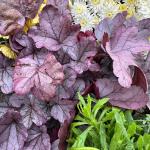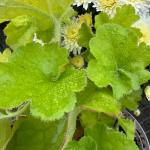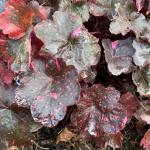A monthly e-newsletter from UMass Extension for landscapers, arborists, and other Green Industry professionals, including monthly tips for home gardeners.
Click on the headings below to jump to that section of the newsletter.
In This Issue
- The 2025 UMass Garden Calendar... Now Available!
- Registration for our 2024 Green School is Closing Soon!
- Plant of the Month - Heuchera
- Trouble Maker of the Month - Ticks
- What's Up With the Yellowjackets?
- Q&A - Overwintering Summer Bulbs
- Garden Clippings: Tips of the Month
- Herbicide Registration and the United States Environmental Species Act (ESA)
- Upcoming Events
To print this issue, either press CTRL/CMD + P or right click on the page and choose Print from the pop-up menu.
The 2025 UMass Garden Calendar... Now Available!
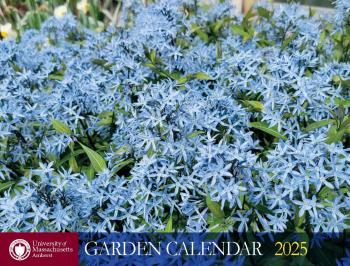 UMass Extension works with the citizens of Massachusetts to help you make sound choices about growing, planting, and maintaining plants in our landscapes, including vegetables, backyard fruits, and ornamental plants. Our 2025 calendar continues UMass Extension’s tradition of providing gardeners with useful and practical information. Many people also love the daily tips and find the daily sunrise/sunset times highly useful!
UMass Extension works with the citizens of Massachusetts to help you make sound choices about growing, planting, and maintaining plants in our landscapes, including vegetables, backyard fruits, and ornamental plants. Our 2025 calendar continues UMass Extension’s tradition of providing gardeners with useful and practical information. Many people also love the daily tips and find the daily sunrise/sunset times highly useful!
As always, each month features:
- An inspiring garden image.
- Daily gardening tips for Northeast growing conditions.
- Daily sunrise and sunset times.
- Phases of the moon.
- Plenty of room for notes.
- Low gloss paper for easy writing.
Images in the calendar, details, and ordering info.
The featured article is Backyard Apple Basics. Apples are among the most common tree fruits and are well-adapted to our local climate. For success in the home orchard, cover the basics! Plant at least two different compatible varieties near each other for cross pollination, fertilize annually to support new shoot growth and prune to promote proper tree structure, and choose resistant varieties to reduce disease problems; consider traps for insect pests.
Our 2025 calendar offers guidelines for proper pollination, effective pruning, how and when to fertilize, and pest management. We also include suggestions for apple varieties suited for the home orchard as well as an update on how planting sunflowers nearby can serve as a trap crop for pests and support for beneficial insects.
COST: $14.50, with bulk pricing rates apply to orders of 10 copies or more.
Proceeds from sales of the annual Garden Calendar benefit the work of UMass Extension’s educational programs.
Registration for our 2024 Green School is Closing Soon!
UMass Extension’s Green School is a comprehensive 60+ hour certificate short course that offers fundamental horticultural training in a compact time frame.
Who Should Attend? Professional practitioners such as landscapers, lawn care providers, nursery operators, sports field managers, public and private grounds managers, DPW, professional gardeners, landscape and garden designers, and others in the green industries. Both experienced individuals, as well as those aspiring to be, will benefit from this course.
Where? Entirely virtual in 2024, taught by UMass Extension Specialists, UMass faculty, and distinguished guest instructors.
When? Tuesday, Wednesday and Thursday afternoons 1:00 to 4:30 pm from 10/29/2024 thru 12/19/2024.
How? The curriculum emphasizes a systems-based approach to plant and land care based on current research and is built on a framework of Best Management Practices (BMPs) and Integrated Pest Management (IPM).
Choose one of two specialty tracks (the Arbor track is on hiatus in 2024):
- Landscape Management
- Turf Management
For complete information, detailed schedules and registration options, go to https://ag.umass.edu/greenschool. Note that registration closes on Friday, October 18, and the course starts on Tuesday, October 29!
Why Choose Green School?
- A robust alternative or a stepping stone to a more involved degree program.
- Convenient yet rigorous remote learning from the comfort of your home or office.
- In-depth, research-based training for skills that are in high demand, and are applicable to active and engaging outdoor work.
- Two educational track options to fit your personal goals.
- Structured interaction with University educators and researchers.
- Competitive fees and tuition assistance options.
- An established program with a 30+ year history and a certificate that carries weight in the industry.
Move your career or business forward, and achieve better results with a smaller overall impact!
Plant of the Month
Heuchera spp.
A new Heuchera seems to find its way into this author’s garden every year; this year’s addition – 'Midnight Rose'. What exactly is it about Heuchera that draws me in? The rainbow of foliage colors? The spires of airy flowers? The plant nerd tendencies to want to find the right cultivar to provide interesting foliage color in every light environment? Whatever it is, a minimum of 10 cultivars have found their way into my garden, many shuffling around year to year as the gardens (and light conditions) change and new cultivars find a home.
Heuchera, commonly referred to as coral bells or alumroot, is a genus with around 55 species native to North America. There are five species commonly used for hybrid development that include H. sanguinea, H. americana, H. micrantha, H. villosa, and H. cylindrica. Although Heuchera americana is not native to Massachusetts its native range does extend to Connecticut. Cultivars and hybrids are what dominate the market.
Walking into a garden center or nursery dozens of options present themselves, sometimes an old favorite is gone, but a new option is always there to be discovered. The foliage really steals the show. Rounded lobes and long petioles spread from the basal mound. Plant size varies by cultivar with some staying quite small (foliage of ‘Plum Pudding’ growing up to 8” tall and 16” wide) while others can be larger than expected with ‘XXL’ growing up to 24” tall and 40-48” wide! Foliage comes in shades of purple, red, orange, bronze, green, yellow, black, blue-green, and silver. Leaves can be variegated, have contrasting vein colors, or different shades for the upper and underside of the leaf. Flower spikes can range from 5” tall up to 40” high. The small, pendulous, bell-like flowers are on wiry spires in late spring to summer, with removing spent flower stems providing an opportunity for rebloom. Flowers come in shades of white, pink, coral, or red.
An organically rich, humusy, well-drained soil is preferred. Parentage determines preference from sun to shade and unfortunately parentage is not always known. Most prefer part shade but there are options from full sun to shade (sometimes experimenting is needed). When grown in full sun consistent moisture is important. Scorch and foliage decline are common in full sun and inadequate moisture. Frost heaving can be a problem with fluctuating winter temperatures. Winter mulch helps. Best uses are as accents in rock gardens, open woodland gardens, and as edgers along walkways. They can stand alone but have the greatest impact in mass. The contrasting foliage colors make great combinations with Hosta and Astilbe.
Foliage is evergreen to semi-evergreen depending on the winter. This past winter, plants performed well in the authors western Mass garden thanks to the milder winter. Removing damaged foliage in spring helps improve appearance; with harsher winters often meaning more damage. Plants can be divided every 3-4 years in the spring.
Related are the Heucherella hybrids. Heucherella, commonly called Foamy Bells, is an intergeneric hybrid between Heuchera and Tiarella. Plants combine the traits of the parents with foliage colors coming from Heuchera and deeper lobes, serration, and leaf blotching from Tiarella. Heucheralla tend to favor more shaded areas. Heucheralla ‘Red Rover’ in its first season in the authors garden had some burnout in full sun (which it is touted to handle) and faded from a bright red to a copper orange color with olive undertones over the course of the summer. New growth has emerged with cooler fall temperatures, but it has remained more of the bronze orange color.
The list of potential cultivars would be quite extensive with Missouri Botanical Garden’s plant finder describing over 100. What will next year’s addition to the Bayer garden be? Only time will tell but another Heuchera I’m sure will find it’s way in.
Mandy Bayer, Landscape Plant Specialist
What’s up with the Yellowjackets?
Take-Home Points:
- The southern yellowjacket, (Vespula squamosa), does not appear to be very prevalent in Massachusetts at this time. Further research could shed some light on their distribution in the state. Nonetheless, this species is recently receiving a lot of attention in the news. If you suspect you’ve seen one, you can report them here: https://www.inaturalist.org/taxa/233560-Vespula-squamosa .
- In general, conflicts between yellowjackets and people increase in the fall (August through September). This includes both native species, such as the eastern yellowjacket (Vespula maculifrons), and introduced species with a longer history and presence in the state (the German yellowjacket, Vespula germanica). This is because the number of yellowjackets per colony increases from spring through fall, with peak numbers occurring around late summer holidays, like Labor Day. They also like the same foods we like to eat outside at picnics and fairs – yellowjackets forage primarily for sugar at the end of the season. This is in contrast to earlier in the year, when foragers primarily hunt for insect protein. Yellowjackets are also attracted to overripe fruit left on plants.
- If you encounter wasps while eating outdoors, the best practice is to let them help themselves to the food. Avoid swatting at them, as this could invoke defense behaviors. After they have gone, take precautions to cover, finish, or remove the food.
- The presence of yellowjackets will cease as soon as we receive the first hard frost of the season. All the workers are killed at that time. Only a single queen will overwinter, and she will emerge next spring to begin her own colony.
What’s up with the Yellowjackets?
You may have recently seen some excitement in the news about yellowjackets (September 2024: southern yellowjackets in Massachusetts). Wasps are in the order Hymenoptera, which also includes bees, ants, and sawflies.Yellowjackets are members of the family Vespidae, which include social paper wasps and yellowjackets, for example, which form colonies and have different castes. This family is also home to many solitary wasp species, and the majority of wasps worldwide are solitary.
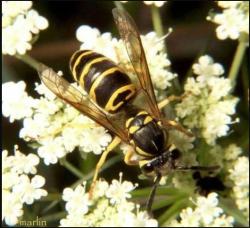
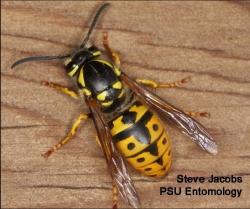
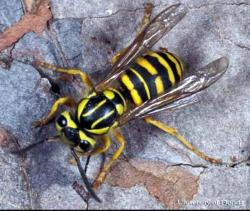 Photos from left to right: adult female eastern yellowjacket (Vespula maculifrons, photo: Bruce Marlin). German yellowjacket overwintering queen (Vespula germanica, photo: Steve Jacobs, PSU Entomology). And southern yellowjacket adult female (Vespula squamosa, photo: Lyle J. Buss, University of Florida, IFAS).
Photos from left to right: adult female eastern yellowjacket (Vespula maculifrons, photo: Bruce Marlin). German yellowjacket overwintering queen (Vespula germanica, photo: Steve Jacobs, PSU Entomology). And southern yellowjacket adult female (Vespula squamosa, photo: Lyle J. Buss, University of Florida, IFAS).
Massachusetts is home to many insects in the family Vespidae, but recently the yellowjackets are receiving some attention. The eastern yellowjacket (Vespula maculifrons) is found in the eastern United States and is native to Massachusetts. A non-native yellowjacket, such as the German yellowjacket (Vespula germanica) was accidentally introduced to the temperate regions of the world, including eastern North America, in the 1970’s. Recent concern in the news is that the southern yellowjacket (Vespula squamosa), is becoming prevalent in Massachusetts. While it has been seen in our state, the reports are currently very infrequent. The historical range of the southern yellowjacket has been from Iowa to Texas and points east. It also extends southward into Mexico and Guatemala.
Further research is necessary to determine the current distribution of the southern yellowjacket in Massachusetts and New England. It is thought that with mild winter temperatures due to climate change, it could be possible for this species and many other insects to expand their range northward. However, this is a very complex process that will take time to play out, and research to fully understand. Predicting changes in insect population distribution due to climate change is incredibly complex. Entomologists need to consider temperature, individual insect phenotypic and genotypic flexibility, and many other factors.
More About the Southern Yellowjacket:
Nesting Habits:
The southern yellowjacket (Vespula squamosa) creates both ground and aerial nests. Ground nests occur on or below the ground surface, and are the most common nesting strategy for southern yellowjackets. Aerial nests occur in trees or other structures, and may be found in unique areas, including stacked hay bales, wall insulation, or ceiling voids.
The southern yellowjacket has been reported to produce massive nests – some of the largest reports from Florida indicate that they can reach 7-8 feet in width and depth. They create paper nests that contain comb, which also can be present in impressive amounts. The paper nest is created by chewed up plant-based fibers. They are fond of creating nests in disturbed habitats, like yards and roadsides. In fact, up to 60% of colonies have been reported from parks, picnic grounds, and golf courses in a study completed in Georgia and Western North Carolina.
Most nests are annual, meaning they die off when cold temperatures arrive. In southern states, some can survive year-round because of the warmer climate. For example, this happens in Florida and is why the colonies can grow so large in that state.
Biology:
Nests are started by a single female – a queen – which overwinters in protected locations. Nests grow throughout the spring and summer, and by the fall can contain up to 4,000 southern yellowjackets. Most of the individuals are smaller-sized workers, and reproductive males and females are produced by the colonies in the fall. Each colony has three castes – yellow and black workers that are approximately 3/8 inch in length; larger reproductive males are ¾ inch long and have a burnt orange color; and reproductive females are larger than both and orange.
A note about the eastern yellowjacket, Vespula maculifrons, whose queens are not as large as those of the southern yellowjacket, Vespula squamosa. The larger southern yellowjacket queen has an advantage over the smaller eastern yellowjacket queen because she often will take over the nest the eastern yellowjacket queens create in the spring.
This is referred to as being a social parasite – the southern yellowjacket taking over the colony of the eastern yellowjacket. Some research has shown that southern yellowjacket queens will also fight each other for the colony as well – anywhere from 2-25 or more additional, dead queens were found upon dissecting a southern yellowjacket colony. Some are kicked outside, others are “papered” inside the nest envelope walls.
Nuisance, Safety, and Removal of Colonies
It is quite common for people to experience annoyance and sometimes unwanted stings from yellowjackets in the fall. This is the time of year where both native and non-native yellowjackets may exhibit aggressive behavior. They are particularly attracted to food that contains sugar and protein. Soft drinks, fruit, sandwiches – any picnic items. Stay still and do not swat at a yellowjacket if it is trying to taste your picnic food. Wait until it flies away and then either finish, cover, or remove the food from the area.
Yellowjacket colonies on private property can be a serious health and safety risk for individuals with allergies to wasp, bee, or hornet stings. If you or a family member has a known allergy, hire a pest management professional to remove the colony safely. Consult a physician for individual safety procedures for anyone with a known allergy.
Even if you do not have an allergy to these insects, there are some situations where the presence of a colony cannot be tolerated - such as in areas frequented by people (near doorways, walkways, garages, picnic tables, and other structures).
Like other yellowjackets, the southern yellowjacket can present a conflict with people if their colonies are formed in close proximity to where people are (either in landscapes or inside the walls of homes). If you are dealing with a large yellowjacket nest that is in a location that cannot be avoided (and thus left alone and coexisted with) by people, it is recommended that you hire a pest management professional to help you get rid of the colony. This is especially true of nests in buildings or walls.
Otherwise, if the nest is in an area unused by people, the best approach is to avoid them and leave them alone. The nest will die off at the first hard frost, all but the overwintering queens will die.
If you must get rid of a colony yourself, here are some basic safety tips: it is important to take precautions to avoid being stung. Wearing a beekeepers veil (if you have one) with protective clothing and working at night or dusk when temperatures are cooler and when these insects are less active, are two of the most effective precautions. Aerosol wasp and hornet sprays injected into the entrance hole are usually quick and effective, and are labeled for and can legally be used to kill a yellowjacket colony. However, if the insects are in a remote location and can be avoided - it is possible to live and let the yellowjackets do the same.
Tips to Protect Property Managers (Landscapers, Arborists, Tree Climbers, and other Professionals:
- Be aware of the possibility for yellowjacket nests to be found in the ground, in stone walls, in shrubs and trees, in tree trunks and stumps, among piles of stone, beneath planters, in wood or lumber stacked outdoors, and in the walls and eaves of buildings. They may also be found near water, such as nearby pools or faucets.
- Unlike a honeybee, yellowjackets can sting repeatedly.
- Wear light colored clothing since yellow jackets are attracted to brightly colored clothing and to dark clothing.
- Do not wear fragrances i.e. after-shave lotions, perfumes, hair products, etc, as these may attract the wasps.
- Keep a lid or cover on sweet beverages and other foods when working outdoors.
- Check work areas for nests before starting the job. Vibrations from equipment used outdoors can be enough to stir the wrath of yellow jackets.
- Have available a can of wasp and hornet spray (aerosols containing pyrethrin or other active ingredients) to apply to nests that are found near work areas. Remember, a MA pesticide license is required for application of general use products on properties you are working on (that you do not own).
- If a nest is disturbed, walk away slowly (rapid movements result in aggressive responses by yellow jackets) keeping your face covered with your hands.
Be on the Lookout for the Northern Giant Hornet
If you see a suspicious vespid wasp, yellowjacket, or hornet there is interest in reports of the northern giant hornet, or Vespa mandarinia, and those can be sent to the Massachusetts Department of Agricultural Resources: https://massnrc.org/pests/report.aspx . Hornets are very similar in appearance to yellowjackets, however in the case of the northern giant hornet they are much larger: adult hornets are very large, with workers 1-1.5 inches long and queens up to 1.75 inches long. More information about the northern giant hornet can be found, here: https://massnrc.org/pests/pestFAQsheets/asiangianthornet.html . This non-native insect is not currently known to Massachusetts, however is of concern due to the threat it poses to pollinators such as wild and managed honeybees.
References
- Massachusetts Introduced Pests Outreach Project: Northern Giant Hornet
- Nesting Biology of the Southern Yellowjacket, Vespula squamosa (Hymenoptera: Vespidae): Social Parasitism and Independent Founding (MacDonald and Matthews, 1984)
- PennState Extension: German Yellowjackets
- Report the Southern Yellowjacket on iNaturalist
- Texas A&M Agrilife Extension Southern Yellowjackets
- University of Florida IFAS Extension: Yellowjackets and Hornets
Tawny Simisky, Extension Entomologist, UMass Extension Landscape, Nursery & Urban Forestry Program
Nicole Bell, UMass Extension Educator III – Pollinators
Trouble Maker of the Month
Tick or Treat: My Top 4 Myths Surrounding Deer Ticks
It’s that time again.
Expect to see adult deer ticks from this point through next spring. Up to 1 in 2 deer ticks may carry the pathogen that causes Lyme disease. They are also known to transmit at least 4 other diseases in this area. Bites can be avoided, given the correct information. But only one piece of incorrect information can leave people exposed. Given the risk, I’m going to walk through a series of myths regarding deer ticks.
Myth 1: Ticks are found in tall grass. Avoid tall grass.
Tall grass and deer ticks have no direct association.
The most reliable predictor of where you’ll find deer ticks is the proximity to the tree line. The presence of vegetation (not necessarily grass), leaves, and shade will provide the ideal habitat for them. Many animals that deer ticks feed either live in or move through these ecotonal areas. Short, mowed grass will still be a risky area, if it’s located near a tree line. Conversely, you’ll rarely find ticks in tall grass exposed to direct sun and away from the tree line.
Myth 2: Repellents are poisonous to ticks.
Partially true. With chemicals, it’s the dose that makes the poison. Even all-natural products, such tea tree oil, are poisonous depending on the dose. This is why we always urge people to follow labels when applying repellents. The instructions indicate how much and how often a repellent should be applied.
Despite being called “repellents,” the primary function is impeding detection by the tick. Deer ticks have no eyes. They can detect light and shadow via photoreceptors but cannot resolve images. Deer ticks are heavily reliant on their ability to smell a potential host through pits on their legs called Haller’s organs.
Traditional repellents, such as those containing DEET and picaridin, hinder the functioning of Haller’s organs. By wearing them, ticks, which have no eyes, will also struggle to smell you.
Myth 3: Ticks climb trees and jump onto you as you pass by.
See above. Deer ticks have no eyes and cannot resolve images. For a deer tick to fall out of a tree onto you would take an extreme stroke of luck on the tick’s part.
In addition, deer ticks are highly sensitive to desiccation. If humidity is under 82%, deer ticks are unable to retain water and will eventually die. Climbing a tree would not only represent a risky gamble but would also expose to tick to adversely dry conditions.
Myth 4: Ticks die in the winter.
Deer ticks have a 2-year life cycle. They can live through up to 2 winters. But they are not impervious to cold. They will succumb to freezing around -4 to 5°F. That said, ticks are well-adapted to winters in New England and thrive in locations much colder than Massachusetts.
One of the most significant ways ticks stay warm is hunkering down under leaves. Not only do leaves retain much needed moisture for ticks, but they also provide insulation. There can be as much as a 40-degree difference between air temperature and temperature underneath leaves and snow.
Rake leaves this fall away from heavily used areas around your yard. Be cautious of piling them up along the edges near the tree line where most deer ticks will reside. If you opt to “leave the leaves” to support native wildlife, be advised that ticks are native wildlife that benefit from this as well.
Blake Dinius, Plymouth County (MA) Entomologist
Q&A
Q: What is the best way to dig and store summer bulbs, such as dahlias?
A: Summer bulbs are plants that have storage organs (bulbs, corms, rhizomes, tubers, etc) that cannot overwinter successfully or reliably in the ground in the Northeast. Some common examples include Begonias, Caladium, Calla, Canna, Dahlia, Elephant Ears, and Gladiolus amongst others.
Summer bulbs are lifted/dug in the fall for overwinter storage and replanting the following spring or summer. Most species can be dug when the foliage begins to wither or just before or after a light frost; waiting until a hard freeze should be avoided. Summer bulbs are best lifted when soil moisture is on the dry side. While this may not always be possible, paying attention to the 10-14 day forecast is useful for scheduling; both for monitoring frost potential and soil moisture.
Lifting bulbs should be done with care, using either a shovel or garden fork and loosening the soil around the plant before lifting. Avoid creating wounds or bruises during the process that may lead to decay in storage. Whether to leave or remove foliage at lifting is debatable. Fleshy stems are often removed especially if they are prone to rot, whereas thin stems and leaves are often allowed to dry and wither before removing. Another debatable situation is how to clean the bulbs: to use water or a brush. Either will work and is best determined based on the conditions at lifting. If water is used to clean, having a location for rapid drying is helpful. After drying the dug bulbs in a cool, dark, dry location for a couple days to a couple weeks, any remaining withered tissues can be removed.
There are many ways to store and overwinter summer bulbs. A location with moderate temperatures around 45-50ºF is ideal, avoid locations that freeze. Humidity is also important; if humidity is too low bulbs will desiccate in storage, and if too high, the likelihood of rot greatly increases. A moderate humidity of 50-60% is ideal. Summer bulbs are typically stored in bags, crates, pots, or trays filled with dry peat moss, saw dust, pine shavings, shredded newspaper, vermiculite or perlite. Check the bulbs in storage frequently and remove any with signs of decay, desiccation, or rot.
Don’t forget to label plants, this rookie mistake is painful, especially when saving multiple colors of the same bulb. Attaching labels with elastic bands to the bulbs, using paper bags, or a Sharpie directly on the bulb may be an option.
Q: What are the best plant identification resources? Apps?
A: Plant identification is a great skill to have as an arborist, gardener, landscaper, or naturalist. I frequently get questions about which apps are best for plant identification. While apps have come a long way in plant identification, there is still room for improvement. A great review of several plant identification apps from Michigan State University can be found at http://www.canr.msu.edu/news/plant-identification-theres-an-app-for-that-actually-several. An app called PictureThis was at the top for accuracy in the MSU trial.
While many of the apps are just a click away from a plant identification, I find the use of a dichotomous key to be more valuable. A dichotomous key requires the use of terminology about plant biology, morphology and phenology. The frequent use of such keys will help build your plant identification skills and build your general knowledge about plants. So, the next time you get stumped by a plant identification, consider one of these resources to find the answer. I guarantee you will learn more than just the plant names.
Numerous keys for all types of plants can be found at Go Botany.
Virginia Tech has great online dichotomous keys for woody plant ID: https://dendro.cnre.vt.edu/dendrology/idit.htm
For herbaceous plants - Newcomb’s Wildflower Guide by Lawrence Newcomb
For weeds – Weeds of the Northeast 2nd Edition, Joseph C. Neal, et al.
Excellent for learning terminology – How to Identify Plants, H.D. Harrington
Plant ID resources from UMass Extension: http://ag.umass.edu/landscape/fact-sheets/plant-identification-online-resources
Garden Clippings: Tips of the Month
October is the month to . . . .
- Take precautions to avoid tick bites when working outdoors. The acronym AWARE (http://www. globallymealliance.org) is an easy-to-follow protocol: Avoid locations where ticks are most likely to be, such as along woodland edges; Wear clothing protectively—put on a hat and long-sleeved shirt, tuck pants into socks; Apply EPA-approved repellents, such as those containing DEET, picaridin, and permethrin, according to label instructions; Remove clothing after coming indoors and throw in the dryer for 10-15 minutes at high temperature to kill deer ticks; and Examine—a daily full-body check for ticks is key to finding ticks that evade the preventive measures outlined above.
- Plant garlic. Garlic prefers nutrient-rich, well-drained soil, so incorporate plenty of compost and if soil is “heavy” (high clay content), mound it into raised planting beds. Choose large bulbs and separate them into individual cloves just before planting. Plant cloves about 2 inches deep and 4-6 inches apart within a row.
- Sow spinach seed for harvesting in late fall or early spring. Spinach seedlings may grow a few inches this fall, and can be protected with straw mulch or floating row cover just as the ground starts to freeze.
- Weed strawberry beds. As their fruit buds are forming in the fall, strawberries do not want competition from weeds for water and nutrients. Such competition may lead to fewer fruit buds.
- Leave ornamental grass uncut when undertaking fall cleanup in the perennial garden. Leaf blades and seedheads provide winter interest, particularly when coated with frost or a dusting of snow, and offer habitat to an assortment of wildlife. An added benefit to leaving top growth in place until late winter: the crown of the plant is protected from temperature fluctuations.
- Plant spring flowering bulbs, such as daffodils, crocus, snowdrops, alliums, and hyacinth in sunny spots with well-drained soil. Group bulbs in large numbers for visual impact. Mulch after planting to allow the bulbs time to develop roots before the ground freezes.
- Lift dahlia tubers and other tender bulb-like summer flowers such as canna and gladiolus after frost and store indoors in a cool, frost-free location. Cleaning and storage recommendations abound, and some experimentation may be required to determine the best methods for an individual gardener’s situation.
- Continue planting trees, shrubs, vines, and perennials until mid-October. Later plantings may not have time to establish an extensive root system before the onset of cold soil temperatures. Soak soil thoroughly prior to planting since rain has been sparse this autumn and water after planting as needed until the ground freezes.
- Install physical barriers such as tree guards or hardware cloth collars to protect valuable trees from animal damage. Eliminate vole cover by clearing grass and weeds from around the base of tree trunks.
- Make several passes with the lawn mower over fallen leaves to chop them into small pieces. Chopped leaves make an excellent soil amendment or garden mulch.
- Deconstruct annual container plantings. If plantings are free of disease, compost plant material and save potting soil for future use. Clean insides of containers with a stiff brush to remove any remaining soil before storing them appropriately.
- Take care not to over-water nor over-fertilize houseplants. As days shorten and sunlight becomes less intense, plant growth slows and a plant’s need for water and nutrients decreases.
Jennifer Kujawski, Horticulturist
Herbicide Registration and the United States Endangered Species Act (ESA)
Background information on the Endangered Species Act
The Endangered Species Act (ESA) establishes protections for fish, wildlife, and plants that are listed as threatened or endangered; provides for adding species to and removing them from the list of threatened and endangered species, and for preparing and implementing plans for their recovery; provides for interagency cooperation to avoid de-listing species and for issuing permits for otherwise prohibited activities; provides for cooperation with States, including authorization of financial assistance; and implements the provisions of the Convention on International Trade in Endangered Species of Wild Flora and Fauna (CITES). The purpose of the Endangered Species Act is to conserve endangered and threatened species and their ecosystems. Congress passed the ESA in 1973, recognizing that the natural heritage of the United States was of “aesthetic, ecological, educational, recreational, and scientific value to our nation and its people.” It was understood that, without protection, many of our nation’s native plants and animals would be threatened with extinction. NOAA (National Oceanic and Atmospheric Administration) Fisheries also known as the National Marine Fisheries Service and the U.S. Fish and Wildlife Service (U.S. FWS) share responsibility for implementing the ESA. NOAA Fisheries is responsible for most marine and anadromous species. U.S. FWS is responsible for terrestrial and freshwater species. They are also responsible for several marine mammal species like walrus, sea otters, manatees, and polar bears. The two agencies share jurisdiction over several other species, such as sea turtles, Gulf sturgeon, and Atlantic salmon.
What is the link between federal herbicide registration and the Endangered Species Act?
The Environmental Protection Agency (EPA) Office of Pesticide Programs (OPP) is the federal agency that regulates pesticide use. Because the use of pesticides can affect animals and plants (or their habitat), pesticide registrations are considered “actions” that would trigger an endangered species consultation. Due to the complex nature of the process, the EPA has not fully completed the required endangered species consultations with the Services for pesticide registrations in the past, which has left many of those pesticides vulnerable to lawsuits. Should a court move to annul a pesticide registration, that could result in removal the from market. To make pesticide registrations less susceptible to litigation, ultimately all pesticide registrations will comply with the Endangered Species Act.
In the future, what changes can we expect with pesticide registration because of the need to comply with the Endangered Species Act?
Many pesticide labels will likely have changes that could include:
- measures to reduce spray drift
- measures to reduce runoff/erosion
- other measures to reduce pesticide exposure to listed species and their habitat
In short, green industry professionals and agricultural producers should expect to see some new application requirements on their pesticide labels, but there is no need to panic. To date, no pesticide has ever been fully removed from the market based solely on endangered species risks, and that remains an unlikely scenario in the future.
Final words on responsible pesticide use.
Best management practices, the responsible and informed use of pesticides, and environmental stewardship are very important. As green industry professionals, agricultural producers and university pest management specialists it is very important that we support and promote these fundamental principles.
Randy Prostak, UMass Extension Weed Specialist
Upcoming Events
For more details and registration options for upcoming events, go to the UMass Extension Landscape, Nursery, and Urban Forestry Program Upcoming Events Page.
- 10/18/24 - Deadline to register for UMass Extension's 2024 Green School.
- 10/29/24 - Green School begins!
Additional Resources
For detailed reports on growing conditions and pest activity – Check out the Landscape Message
For professional turf managers - Check out our Turf Management Updates
For commercial growers of greenhouse crops and flowers - Check out the New England Greenhouse Update website
For pollinator interests - Check out the Pollinator Buzz
For home gardeners and garden retailers - Check out our home lawn and garden resources
TickTalk webinars - To view recordings of past webinars in this series, go to: https://ag.umass.edu/landscape/education-events/ticktalk-with-tickreport-webinars
Diagnostic Services
Landscape and Turf Problem Diagnostics - The UMass Plant Diagnostic Lab is accepting plant disease, insect pest and invasive plant/weed samples. By mail is preferred, but clients who would like to hand-deliver samples may do so by leaving them in the bin marked "Diagnostic Lab Samples" near the back door of French Hall. The lab serves commercial landscape contractors, turf managers, arborists, nurseries and other green industry professionals. It provides woody plant and turf disease analysis, woody plant and turf insect identification, turfgrass identification, weed identification, and offers a report of pest management strategies that are research based, economically sound and environmentally appropriate for the situation. Accurate diagnosis for a turf or landscape problem can often eliminate or reduce the need for pesticide use. See our website for instructions on sample submission and for a sample submission form at http://ag.umass.edu/diagnostics.
Soil and Plant Nutrient Testing - The lab is accepting orders for Routine Soil Analysis (including optional Organic Matter, Soluble Salts, and Nitrate testing), Particle Size Analysis, Pre-Sidedress Nitrate (PSNT), Total Sorbed Metals, and Soilless Media (no other types of soil analyses available at this time). Testing services are available to all. The lab provides test results and recommendations that lead to the wise and economical use of soils and soil amendments. For updates and order forms, visit the UMass Soil and Plant Nutrient Testing Laboratory web site.
Tick Testing - The UMass Center for Agriculture, Food, and the Environment provides a list of potential tick identification and testing options at: https://ag.umass.edu/resources/tick-testing-resources.

